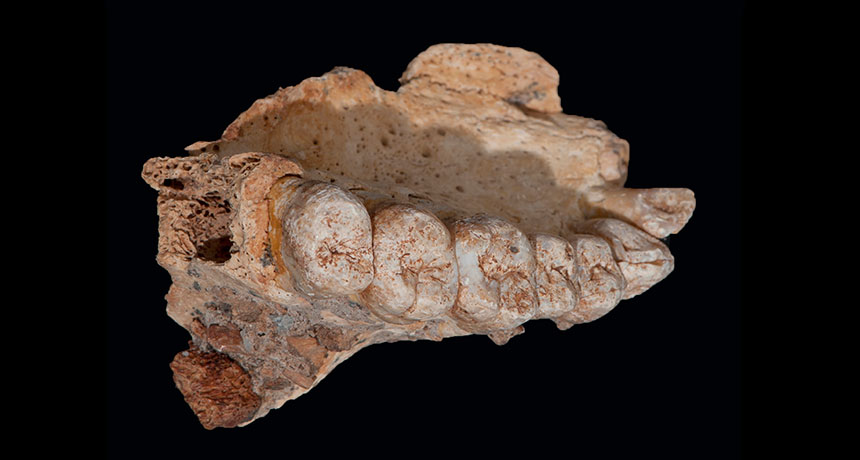Ancient jaw suggests humans left Africa earlier than thought
The fossil, found in Israel, is at least 177,000 years old

Researchers found this fossil jaw in 2002. Analyses show that it’s from a Homo sapiens and is at least 177,000 years old. That suggests humans reached the Middle East from Africa many tens of thousands of years earlier than experts had believed.
I. HERSHKOVITZ/TEL AVIV UNIVERSITY
By Bruce Bower
A fossil jaw unearthed in Israel is speaking up about when humans departed Africa. A new analysis suggests an ancient exodus of our species started much earlier than many researchers had assumed.
Scientists found the jaw in Misliya Cave. That’s on Israel’s Mount Carmel. The fossil includes a partial upper jaw and seven intact teeth (and one broken tooth). There is also part of the cheekbone and roof of the mouth. There is even the bottom of the nasal opening.
The researchers who discovered the fossil believe the remains come from our species: Homo sapiens. And they’ve estimated its age at between 177,000 and 194,000 years old. That suggests that humans could have left Africa and reached the Middle East around 60,000 years earlier than many scientists had assumed.
The researchers describe the fossil in the January 26 Science.
Until now, the oldest known H. sapiens fossils outside of Africa came from two other caves in Israel. Researchers dated them at some 90,000 to 120,000 years old.
The Misliya jawbone “provides the clearest evidence yet that our ancestors first migrated out of Africa much earlier than we previously believed,” says Rolf Quam. He works at Binghamton University in New York. As a paleoanthropologist, he studies fossils and other remains of ancient peoples to better understand their evolution. Quam led the new study along with colleagues Israel Hershkovitz of Tel Aviv University, in Israel, and Gerhard Weber of the University of Vienna, in Austria.
Out of Africa
Our species evolved in Africa. Scientists think that might have happened around 300,000 years ago. The team that found the Misliya jaw say its presence in Israel suggests that humans likely first reached the Middle East more than 200,000 years ago.
Those estimates fit with other evidence from a study of ancient DNA. In that July 2017 study, researchers concluded that H. sapiens interbred with Neandertals in Europe between around 219,000 and 460,000 years ago.
Hershkovitz and his colleagues excavated areas at Misliya Cave from 2001 to 2010. They discovered the fossil jaw in 2002. They also found stone artifacts buried in the same sediment layer as the fossil jaw — suggesting they came from the same time period. Those artifacts included chunks of rock. Sharp flakes had been pounded off of those rocks to use as cutting tools.
The researchers used three dating methods to estimate for the age of the Misliya jaw. In one, they dated the sediment that clung to the jaw, as well as the stone tools. They also calculated ages for the fossil’s teeth.
The Misliya people’s surprisingly early arrival in the Middle East meant that they might have mixed with Neandertals, Hershkovitz says.
Scientists had assumed for decades that only Neandertals had existed in Israel and other parts of Western Asia more than 120,000 years ago. Researchers had believed that H. sapiens from Africa later replaced Neandertals in the Middle East. That would have been between 120,000 and 90,000 years ago. Other fossil finds suggest Neandertals came back to the region around 80,000 years ago.
The Misliya jaw “doesn’t fit in that long-established picture,” says John Hawks. He’s a paleoanthropologist at the University of Wisconsin–Madison.
Some scientists still challenge whether the Misliya jaw is unquestionably human.
For instance, it has a few features in common with Neandertals and other ancient hominids from the Homo family. Yet Quam points out that several aspects of teeth in the Misliya jaw appear only in H. sapiens. To him, “That is why we feel confident in our diagnosis [that it comes from a true human].”
Paleoanthropologists Chris Stringer and Julia Galway-Witham wrote about the Misliya jaw in the same issue of Science. Both of them work at the Natural History Museum in London. And both agree that the jaw came from a H. sapiens. Its discovery suggests “that our species had already left Africa by around 180,000 years ago,” they wrote. Rainy periods in Western Asia between 244,000 and 190,000 years ago may have attracted humans from Africa and Neandertals from Europe, they propose.
Hawks is less sure that the jaw belongs to our species. It’s possible that interbreeding between H. sapiens, Neandertals and perhaps other Homo species in the Middle East could have produced a hybrid population. Individuals of that group might have humanlike jaws connected to bulkier, Neandertal-like bodies, Hawks says. He also speculates that the Misliya remains may come from some Homo species that was closely related to H. sapiens — but not known from any previous fossils.
Indeed, Hawks argues, “This new discovery from Misliya Cave raises more questions than answers.”







